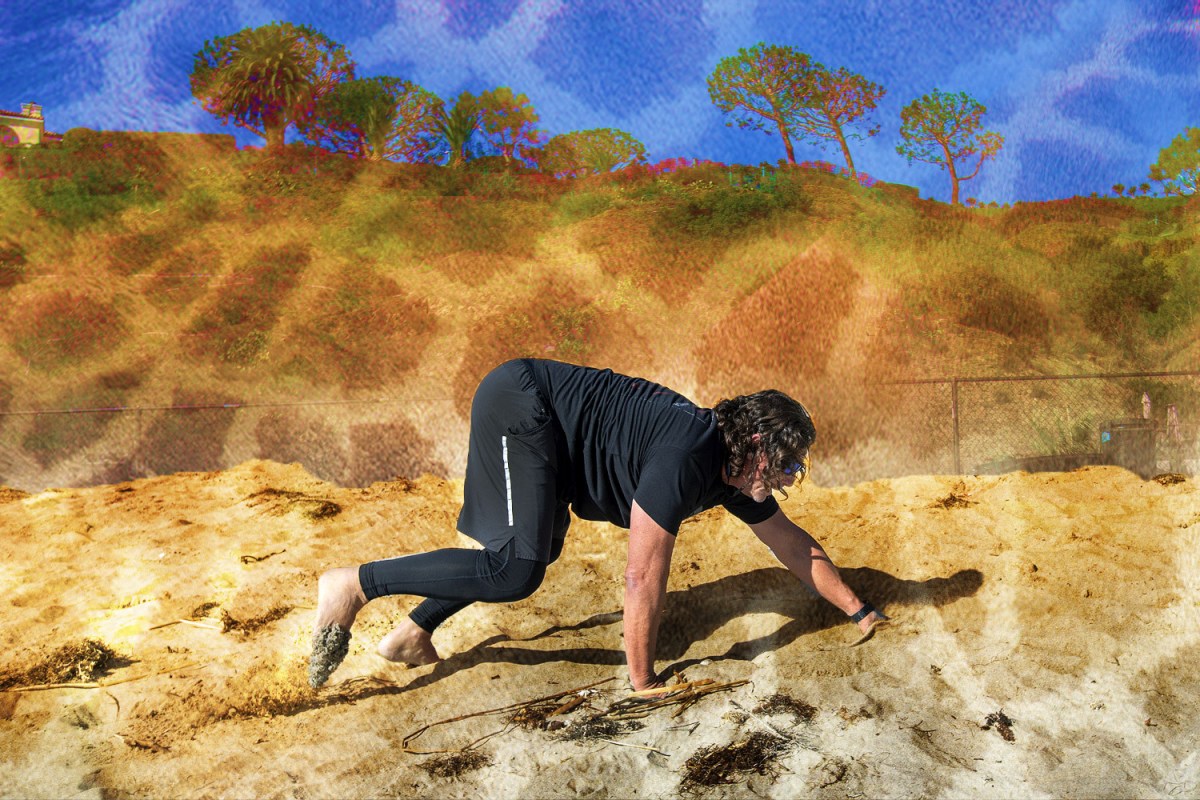A fitness hypothetical for you: if you arrive at an empty football field on a perfect day, with an hour to exercise and no equipment at your disposal, how are you sweating?
Via a few laps with sprinted straightaways, maybe, or a full yoga sequence, or circuits of calisthenics. You really can’t go wrong. For a more energetic, offbeat and full-body workout, though, we recommend mixing and matching “quadrapedal exercise patterns.”
Call it beast mode, if you like: a 12-move workout, inspired entirely by the crawls, hops and shuffles that naturally occur in the animal kingdom. As the phrase suggests, many — including the most famous, the notorious bear crawl — involve moving around on all fours.
Animal moves comprise a extremely difficult form of exercise, demanding a combination of strength, control, flexibility and range of motion. They require you to get on the ground and replay your least favorite high school coach’s most favorite drill. They’ll put you face to face with your body’s achiest areas in a hurry.
But that’s only because animal moves are at odds with the modern “comfort crisis” (to paraphrase fitness writer Michael Easter). They get immediately busy erasing the damage that the sedentary workplace era has done to our shoulders, low backs and hip flexors.
Guys like Mike Fitch — creator of Animal Flow — and Joseph “Da Rulk” Sakoda, the king of sit thrus, are at the forefront of this movement. Their credo: get back on the jungle floor. Use your back, twist your hips, leap as if your life depends on it. Eons ago, it actually did.
Not to mention: while “primal fitness” may seem intimidating or gung-ho, it involves the very sort of movement patterns that kids get up to in the sandbox and in the jungle gym. We lose our pliability (and energy) as we age, no doubt. But we can still retain our love and proclivity for movements that once felt fun and natural.
This guide is a great place to start. From backwards crab walks to kangaroo jumps, deploy this workout next time you come across our mythical football field, or a stretch of sand, or that turfed section in the back of the gym. Stick with them, as hard as they’ll be at first. And remember: the move you hate is usually the one you’re most in need of mastering.
Inchworm
How to do it: Begin in a standing position. Bend forward and touch the ground with your hands, then walk them forward to a plank position. Now, walk your feet towards your hands and stand up again. This move strengthens your core and improves flexibility.
In a workout: This is a great way to ease yourself into other animal-inspired moves. Start with two sets of 10 reps.
Bear Crawl
How to do it: Get down on all fours, making sure your knees are hovering just off the ground. Now move forward, with your opposite hands and feet moving together. This move is wicked hard, but works wonders for your core strength and coordination.
In a workout: Make sure you have enough space to bear crawl four “paces” forward, and four paces backward. Repeat this motion for 30 seconds at a time, then take a minute of rest. Four sets, total.
Backwards Crab Walk
How to do it: This one’s likely familiar from elementary school P.E. From a seated position, lift your body by pressing down with your hands and feet. (Hands can point backwards or out to the side, whatever is more comfortable.) Move backwards, using alternating hands and feet. Try to move in a slow, controlled manner, and lift your your hand and foot at the same time.
In a workout: Travel 15 feet backwards, then walk back to the starting position and repeat. 10 reps. This move can also be performed similar to the bear crawls, whereby you travel backwards for for four paces, then return back to the starting position.
Frog Jump
How to do it: Squat down low, touching your hands to the floor between your feet. Then explode like a spring-loaded frog — desperate to make it the next lily pad — while reaching your arms high into the air.
In a workout: Perfect for HIIT circuits, these pair easily with “non-animal” staples like burpees and mountain climbers. Do sets of 10 frog jumps, then take a 30-second rest. Repeat this four times.
Flying Squirrel
How to do it: Lie down on your stomach with arms and legs outstretched, then lift your arms and legs simultaneously, holding them there briefly before releasing.
In a workout: Do three sets of 15 repetitions. It’s okay to start with 10 reps to a set, if necessary. These are deceptively difficult. If you find them too easy, on the other hand, try your hand at the fabled flying squirrel burpee.
Duck Walk
How to do it: Start in a deep squat position, keeping your back straight, your hips low and your weight firmly on your heels. Now, begin walking forward with small steps, maintaining the squat. Try not to lean forward too much (will put undue stress on the knees), and keep your back straight.
In a workout: There’s a basic workout for this move — duck walk for 30 seconds, rest for one minute, four sets. It’s worthy of your time. Our offbeat recommendation, though? Go duck walk the football field near your house. Barefoot.
Scorpion Reach
How to do it: Start in a plank/push-up position. Lift one leg off the ground, bend the knee and push it towards the opposite hand. Then rocket it backwards, tilting it towards your opposite shoulder. Hold for a second, before pushing it towards the opposite hand again. There is nothing intuitive about this one, so tinker until you’ve established a flow.
In a workout: Just try 10 on each side, then rest for a minute. Four sets if you can.
Gorilla Shuffle
How to do it: This one’s a lateral movement. Start in a deep squat position, with your arms hanging loose. Jump to the side slightly, guiding your hands along the way like a silverback shuffling along the jungle floor. Once you master it, it’s a more natural approach to that resistance band shuffle you’ve likely seen people do at the gym.
In a workout: Try this one for time — two shuffles to the right, two shuffles to the left, for 30 second intervals. Three sets.
Spider Walk
How to do it: Another tricky one. Start in a high plank position, with your hands directly beneath your shoulders and your body straight. Lower yourself towards the ground, bending your elbows out to the sides, while keeping your body just inches from the floor. Step one foot just outside of your hand on the same side. Now move your other hand forward, followed by the opposite foot. Repeat this pattern to ‘walk’ forwards. Here’s a closer look.
In a workout: You’ll want to set a concrete distance here, as the frenetic movements don’t have obvious subdivisions. Try 15 yards or so. Then walk back to the start. Three sets total.
Leopard Crawl
How to do it: The bear crawl’s elegant (and more difficult) cousin. It’s similar to the popular move, except your knees are much closer to the ground, almost brushing it, and the body remains parallel to the floor, instead of morphing into an inverted V-shape. Get down on all fours, keeping your body close to the ground. Crawl forward, moving opposite hands and feet together.
In a workout: Make sure you have enough space to leopard crawl four “paces” forward, and four paces backward. Repeat this motion for 30 seconds at a time, then take a minute of rest. Four sets.
Kangaroo Jump
How to do it: Definitely the most fun and intuitive animal move here. Stand upright with your feet hip-width apart. Lower your body into a half squat, swing your arms back and then forward as you jump forward, doing your best to land softly. Then immediately sink back into a half squat for the next jump. This animal move also falls under the umbrella of plyometric movements.
In a workout: Do 10 to 20 kangaroo jumps in a row, somewhere with lots of space. Rest for a bit. Do two more sets. Your local park’s the Outback for the afternoon.
Aboreal Dead Hang
How to do it: One is not like the others. While everything else here can be performed on a yoga mat or a football field, this move requires a pull-up bar (or something else sturdy to hang from, like a tree branch). Grasp the branch/bar firmly with both hands, and simply let your body hang. Your feet should not be touching the ground, your body should be fully extended. Keep your chin tucked towards your chest.
In a workout: This isn’t a high-intensity move. Just plug in a minute or more at the end of your workout to help stretch out your back, arms, and shoulders. Gradually increase the length of time you get better at maintaining the hang.
Whether you’re looking to get into shape, or just get out of a funk, The Charge has got you covered. Sign up for our new wellness newsletter today.
























